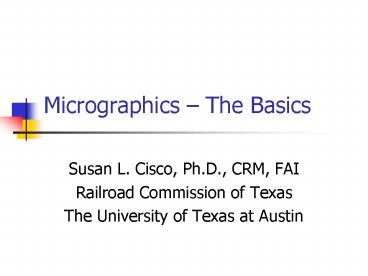Micrographics The Basics - PowerPoint PPT Presentation
1 / 28
Title:
Micrographics The Basics
Description:
Provides fast retrieval of high-quality document images with savings in labor ... Can provide electrostatic plain paper prints of the image displayed on the screen. ... – PowerPoint PPT presentation
Number of Views:190
Avg rating:3.0/5.0
Title: Micrographics The Basics
1
Micrographics The Basics
- Susan L. Cisco, Ph.D., CRM, FAI
- Railroad Commission of Texas
- The University of Texas at Austin
2
Agenda
- Explain fundamentals of a microfilm system
- Identify various photographic films used
- Describe effects of reduction ratios,
magnification ratios, image orientation, image
density, contrast, and resolution on image
capture and display
3
Agenda (continued)
- List use and benefits of various microforms
- Explain operation, components, and benefits of
microfilm cameras - Describe hardware and software used in film
imaging and display - Discuss preservation issues
4
Microfilm An Overview
- Used for well over half a century
- Reduces storage requirements by 98
- Provides fast retrieval of high-quality document
images with savings in labor and distribution
costs
5
Definitions
- Microform Generic term for any film-based
information storage medium that contains
photographically reduced images - Micrographics Techniques associated with
production, handling, and use of microforms, AKA
film-based imaging
6
Major Micrographic Applications
- Source document filming
- Computer output microfilm (COM)
- Micropublishing
- Library applications
7
Micrographic Standards
- AIIM International (used to be National
Micrographics Assn.) - ANSI (American National Standards Institute
- ISO (International Standardization Organization)
8
Reduction
- Reduction and magnification ratiossize of the
film image compared to the original document. - 24X is most common.
9
Types of Microforms - Roll
- Roll filmmost economical and most frequently
used, suitable for low-reference, long-term
retention, sequentially ordered documents, as
well as high-reference, randomly arranged
documents that are retrieved by automated
systems.
10
Types of Microforms - Flat
- Flat film are sheets of film
- Microfiche
- Jackets
- Aperture cards
- COM (Computer Output Microfilm)
11
Micrographics Advantages
- Reduced space, up to 98
- Legally acceptability
- Stable storage medium
- Increased employee productivity
- File integrity
- Easily duplicated
- Portability
- Reduced mailing costs
12
Source Document Microfilming
- Conversion of paper documents to microform
13
Types of Cameras in Source Document Microfilming
- Rotary
- Planetary
- Step and repeat
14
Rotary Cameras
- Films high volume records. Film and document
advance in the same direction and at the same
speed within the camera. - Filming speeddetermined by skill of the operator
and condition of the documents. - Film unitcontains film, shutter, and lens, which
determines reduction ratio used.
15
Rotary Camera Components
- Lighting controls
- Automatic feed mechanisms
- Receiving trays and stackers
- Check endorser
- Sequential numbering device
- Image-count device
16
Planetary Cameras
- Used primarily to film engineering drawings and
other large documents, AKA flatbed cameras. - Film and document remain still during exposure.
Document to be filmed is laid flat on camera
table (copy board). Amount of light required is
registered through a light meter and light
intensity is adjusted.
17
Other Flatbed Cameras
- Small-document planetary camera (table model
planetary)miniature version of large engineering
planetary camera. Films documents that cannot be
satisfactorily microfilmed on rotary cameras.
Also used for microfilm jacket work and
microfiche work.
18
Step and Repeat Cameras
- Produces microfiche. Images are exposed in
uniform rows and columns on a sheet of 105mm
film. - Updateable microfiche cameraalso a
step-and-repeat camera which used to produce
updateable microfiche. No longer manufactured.
19
COM (Computer Output Microfilm)
- Captures electronic data from the computer on
microfilm without paper intermediary, usually in
the form of microfiche.
20
Measures of Image Quality
- Resolution Measure of the sharpness of the
characters of the image on film. - Density Measure of the amount of light
transmitted through black background, AKA
background density.
21
Film Technology
- Silver halide film. Produces images of negative
polarity. Common film widths are 16mm, 35mm, and
105mm. Packaged in 100- and 200-ft. rolls. Dry
silver film has no wet chemistry used in its
processing (development).
22
Film Technology
- Copy filmused to make duplicates of the
processed camera films. - Diazo filmnon-silver film used exclusively for
contact printing. The latent image is developed
by exposing the diazo film to ammonia vapors in a
development chamber of the duplicating machine. - Vesicular filmdeveloped by a heat process. It
is a reversal film a positive original produces
a negative vesicular copy. Not as effective as
diazo or silver.
23
Film Technology
- Copy film (continued)
- Silver print filmtwo types one is a reversal
film which produces positive copy from a negative
original or vice versa. The other type is a
non-reversal film
24
Film Processing
- Processormachine used to develop microfilm.
Three types of processors deep tank, roller
transport, and straight film path processors. - Development factors include temperature of the
developer, length of time film is in the
solution, condition of the developer, and the
agitation of the film.
25
Readers
- Must have excellent illumination system, good
optics, and provide fast access to the image.
Types of readers - Roll-film readers
- Cartridge readers
- Cassette readers
- Microfiche readers
- Aperture card readers
- Multiformat readers
26
Reader Printers
- Can provide electrostatic plain paper prints of
the image displayed on the screen. - Prices range from 4,500 to 33,000.
27
Computer-Assisted Retrieval (CAR)
- Equipment that uses potential of computer to
allow filming in random order with fast, precise
retrieval.
28
Preservation Issues
- Separate silver and non-silver microforms
- Storage containers need to be acid-free and
corrosion-resistant - Rubber bands are unacceptable
- Use non-acidic paper wraps




















![[PDF⚡READ❤] The Social Worker and Psychotropic Medication: Toward Effective Collaboration PowerPoint PPT Presentation](https://s3.amazonaws.com/images.powershow.com/10095513.th0.jpg?_=202408100210)



![[PDF READ] Free Netter's Essential Histology: Netter's Essential Histo PowerPoint PPT Presentation](https://s3.amazonaws.com/images.powershow.com/10088188.th0.jpg?_=20240729072)


![[PDF] Immunology & Serology in Laboratory Medicine 7th Edition Free PowerPoint PPT Presentation](https://s3.amazonaws.com/images.powershow.com/10076362.th0.jpg?_=20240711081)



